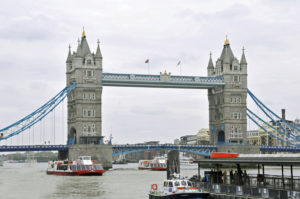
London’s Tower Bridge (Photo by Don Knebel)
London planners wanted a bridge across the Thames just east of the Tower of London that would accommodate tall ships sailing to the port at the London Pool. The solution was a unique combination of bridge-building techniques. Two suspension bridges link the river banks to two 213-feet-tall towers supported on massive concrete piers in the middle of the river. A drawbridge with twin 1000-ton leaves goes between the Victorian Gothic towers, designed to be compatible with the Tower of London. Two walkways 140 feet above the river mechanically connect the towers to anchors on the river banks, providing structural support. When the bridge opened in 1894, at a cost equivalent to $150 million today, the leaves could be raised completely in a minute or so by an ingenious mechanism relying on steam power and pressurized water. The bridge was so successful that it soon put out of business a nearby pedestrian tunnel. The little used upper walkways attracted prostitutes and pick pockets and were closed to the public in 2010.
In preparation for the Silver Jubilee of Queen Elizabeth II in 1977, Tower Bridge was painted red, white and blue and the mechanism for raising the drawbridge replaced by one using electric power and hydraulic oil. The original blue and white colors were restored in 2008. Today, the drawbridge leaves are raised completely in salute when the Queen passes under the bridge. For anyone else, the leaves are raised no higher than necessary to accommodate the passing ship. Persistent rumors that the buyer of London Bridge, now located in Lake Havasu City, Arizona, thought he was buying Tower Bridge are false.
Comments are closed.